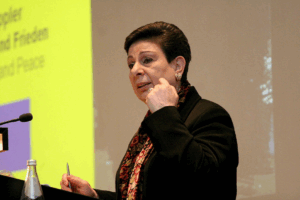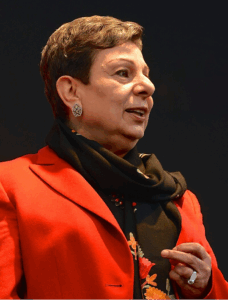Hanan Ashrawi
An Enduring Legacy in the Unfinished Struggle for Palestine
Few advocates of Palestinian liberation have become as familiar a name as Dr. Hanan Ashrawi. A principled activist and gifted speaker with a formidable academic background, she rose to international prominence during the First Intifada in 1988. Later, with the start of the Madrid Conference in 1991, she caught the world’s attention as the official representative of the Palestinian delegation.
In light of the escalating genocide in Gaza and unchecked expansion of the Israeli occupation of the West Bank, writing a portrait of a Palestinian icon may appear tone deaf to the dire reality on the ground. However, it remains important to amplify Palestinian voices on every platform available to bear witness to their perspectives and decades-long struggle for self-determination. As Ashrawi’s life story is inextricably linked to the history of the Israeli occupation of Palestine, this portrait will also highlight key moments in Palestinian history.1)
Lastly, this portrait serves as a tribute to the less prominent Palestinian women whose unyielding courage and resistance continue to shape the ongoing fight for Palestinian self-determination.
“Since the early days of the occupation, it was the women who took to the streets and challenged the army. The women also had taken the initiative of establishing popular committees and alternative structures. They were the ones who would wrestle with the soldiers to rescue their offspring or the children of other women. […] Imprisoned, tortured, harassed, humiliated, or plain excluded and disenfranchised, our women displayed a sense of pride that went beyond victimization, visible in their eyes and bearing.”2)

© Carsten Sohn – Own work, CC BY-SA 3.0, https://commons.wikimedia.org/w/index.php?curid=3166710
Early years of a Palestinian woman
Born in 1946 in Nablus as Hanan Mikhail, she witnessed the Nakba3) after the end of the British Mandate over Palestine and the UN Partition Plan of 1947. This led to the founding of the State of Israel in 1948 along with the forced displacement of around 700,000 Palestinians, 85% of the territory’s population. Among them was Ashrawi’s family who first fled to Amman and later settled in Ramallah, West Bank, which was formally annexed and administered by Jordan from 1950 to 1967.
“From the beginning as a people we were slated for what we call national obliteration. Cast outside the course of history we became the victims of a myth […]: of the land without a people for a people without a land. So this statement, this myth somehow dismissed our very existence, as though our land was empty.”4)
Hanan Ashrawi was educated at a Quaker girls school in Ramallah, attended by the women of her family for generations.5) From an early age, Ashrawi was politicized by her father, Dr. Daud Mikhail, and witnessed him being repeatedly arrested by the Jordanian government. He was a vocal supporter of women’s rights and actively involved in the foundation of the PLO, the Palestine Liberation Organization.
Academic career under occupation
In 1964, Ashrawi enrolled at the American University of Beirut to study English Literature. She joined the General Union of Palestinian Students as well as the General Union of Palestinian Women. She was active in several societies and volunteered in the Palestinian refugee camps in Beirut.
During her studies, the six day war of 1967 (the “Naksa”) broke out.6) Israel used this war to occupy several territories, including the West Bank and East Jerusalem, displacing about 400,000 more Palestinians. Consequently, nearly half of all Palestinians at that time were living in exile. This change of the Palestinian landscape, in violation of a UN Resolution, laid the foundation for decades of Israeli occupation and the ongoing de facto annexation of Palestinian Territories.
Ramallah, where Ashrawi’s family was living, came under Israeli military control. Israel conducted a census in the occupied territories and considered only registered Palestinians to be legal residents. Ashrawi was among those denied re-entry into the West Bank – alongside approximately 90,000 other Palestinians abroad or displaced who were considered “absentees”. The same Israeli Absentee Property Law of 1950 has been used for decades to justify land confiscation.
In exile and separated from her family, the Palestinian struggle became a personal issue for Ashrawi.7) Activism took an even more central role in her life. After graduating in 1970, she found herself with nowhere to go – neither permitted home to Ramallah nor to stay in Lebanon.8) Fortunately, she received a scholarship to pursue a doctorate in medieval English literature in the US. There, she continued her activism by forming coalitions with other student groups.9)
It was not until 1973 that she was allowed to return to her family. She started teaching as a professor of English literature at Bir Zeit University near Ramallah. During her time as director and dean of the Faculty of Arts, she built up the Department of English Language and Literature and was a faculty member until 1995, publishing poems, stories and articles on English and Palestinian culture, literature and politics. In this time, she also married Emil Ashrawi, and they later had two daughters together.
Her academic career was shaped by the escalating Israeli occupation in Palestine: The seizure of land, the exploitation of natural resources, the encroachments of illegal settlements displacing Palestinians and regular administrative detentions were accompanied by increasing repressions against Palestinian culture and identity.10) Meanwhile, the Israeli government exploited different legal techniques in order to deprive the Palestinian population of their rights. During this time, Ashrawi’s involvement in peaceful demonstrations led to charges of incitement and several detentions. In response, she founded a university legal aid committee to provide legal defense for students.11)
The role of women in the First Intifada
It was against this background of suffocating occupation that the First Intifada – the Arab word for “Uprising” – started as non-violent protests all over the Palestinian Territories. The mostly peaceful revolt12) included acts of civil disobedience and boycott of the Israeli economy, as well as the throwing of stones by Palestinian teenagers at highly armed IDF tanks.13) The IDF responded with its full arsenal of military measures, from nightsticks and water cannons to live ammunition. During the entire First Intifada the Israeli army killed approximately 1,500 Palestinians, around 300 of them children. On the other side, around 400 Israelis were killed, half of whom were soldiers.
At that time, Hanan Ashrawi began to play a decisive role in the underlying Palestinian political movement within the Intifada. Every time there was a demonstration in Birzeit, the faculty members had to protect the students from the Israeli army that threatened to violently storm the campus.14) Following a raid in December 1987, the university was closed indefinitely as a “military area” and Ashrawi organized with others to teach their students outside campus, in their homes, abandoned buildings or churches and mosques.15)
“With the schools closed down by Israeli military orders, it was up to us to prevent the forced illiteracy of our children. […] In spite of the occupation, we tried to teach our children how to laugh, to create, and to maintain a sense of joy in their souls.”16)
With the PLO leadership long in exile, the Intifada as a mass civil society revolt was based on popular resistance and grassroot organisation within Palestine. The movement was mainly shaped by women like Hanan Ashrawi, Zahira Kamal and Naila Ayesh. For years before the intifada’s eruption, these women were organizing in women’s groups and other collectives. When the uprising started, they took their efforts into the various villages: they worked with farmers to become more autonomous from Israeli products, they helped women become financially independent, and they organized peaceful protests with women of all ages.
It is this essential – sometimes forgotten or invisible – role of Palestinian women as a backbone of the First Intifada that shaped the popular and peaceful resistance and put actual pressure on the occupation. Ashrawi always considered the fight for freedom from occupation and for freedom from patriarchy as two sides of the same coin.
“Perhaps more than the men, the women embraced the intifada in every possible way. We adopted every prisoner and detainee, claimed as our child whoever was beaten, arrested or harassed. With the intifada, Palestinian women had come into their own.”17)
From civil society to the political representation of a people
Early in the Intifada, Ashrawi broke with the prevailing view that public engagement with Israelis risked “normalizing” the occupation. In order to appeal to the international community and confront Israeli narratives directly,18) she and three other Palestinians debated four Israelis in a televised “town meeting” about the occupation. This appearance was very well received and brought her into the public spotlight.
Ashrawi also participated in several Palestinian-Israeli encounters with women on both sides who were committed to finding a peaceful solution.19) These efforts culminated in the Women’s March for Peace in late 1989 with women from all over the world chanting songs of justice and peace in the streets of Jerusalem. However, following a few women waving the Palestinian flag, the Israeli army charged indiscriminately into the crowd.
Meanwhile, it became necessary to form an institutional representation within the occupied territories – the “Unified National Leadership of the Uprising”, made up of representatives of local organizations, including Ashrawi. Its main tasks were the distribution of official communiqués, the participation in international conferences and the reception of official envoys.20)
This period marked the beginning of a role that would dominate Ashrawi’s life and shape her image on the global stage.
Negotiations between Unequals in Madrid
After the US victory in the Gulf War of 1991, there was a new American impetus for Israeli-Palestinian peace negotiations. Over several months, Secretary of State James Baker met with a delegation of local leaders, including Ashrawi, to ensure and discuss the terms of Palestinian participation at the Madrid Conference in late 1991. As preconditions, Israel insisted on excluding the UN (framing them as anti-Israeli), refused to negotiate with Palestinians from Jerusalem or abroad and demanded a joint Jordanian-Palestinian delegation. Palestinians understood this as an attempt to negate their existence as a people.21)
“To you this […] may be an object requirement to enhance a political career; […]. To us, it is the very substance of our lives. We are discussing the lives and future of our children – of a whole people […] who are negotiating here with you as though their lives are just as normal or just as safe as yours.”22)
At the Madrid conference, Ashrawi, a Jerusalemite, was thus barred from being an official delegate and participated only as a steering committee member and spokesperson,23) bringing the First Intifada’s grassroot momentum to the global stage. It was Ashrawi who crafted the powerful opening speech of Dr. Haidar Abdel Shafi, the official delegation head:
“We come to you from a tortured land and a proud, though captive, people, having been asked to negotiate with our occupiers, but leaving behind the children of the Intifada, and a people under occupation and under curfew, who enjoined us not to surrender or forget. As we speak, thousands of our brothers and sisters are languishing in Israeli prisons and detention camps, most detained without evidence, charge, or trial, many cruelly mistreated and tortured in interrogation, guilty only of seeking freedom or daring to defy the occupation. We speak in their name and we say: set them free.”24)
Ashrawi’s appearances were hailed in regional and international media.25) She was considered the most articulate member of the delegation who “resolutely and proudly [represented] the Palestinian positions”. Her essential role in the peace talks echoed the vocal role of Palestinian women. Palestinians welcomed her straightforward style and commitment, earning widespread support within Palestinian society at the time:
“I was spokesperson, and I vowed to speak in my people’s voice, to put on the mantle of their visibility, and to unfurl before the eyes of the world images of both their melancholy and joy. I would capture their spirit in language, and set it free before witnesses.”26)
The Madrid Conference marked a rare breakthrough after decades of international dismissal of Palestinians. Ashrawi, though cautiously optimistic, saw it as only a small first step.27) Despite her strategic skill and sharp rhetoric, the cards remained insurmountably stacked against the Palestinians.28) The true failure of the process, however, occurred two years later, when the inclusive spirit of the First Intifada was replaced by secret Oslo negotiations.
Oslo and the betrayal of the Intifada
The conclusion of the Madrid conference launched bilateral peace negotiations between Israel and each Arab delegation. Although Israel initially insisted again on negotiating with a joint Palestinian-Jordanian delegation, the persistence of Ashrawi and her colleagues ultimately allowed for direct bilateral Palestinian-Israeli talks.29)
During the negotiations that started in January 1992 and went on for twenty months, the Palestinian delegation put forward serious proposals for self-governance. However, the Israeli side avoided substantive discussions.30) Prime Minister Shamir later confessed to what Palestinians had been warning about all along: that he had intended to drag on “negotiations on autonomy for 10 years”, while “vastly increasing the number of Jewish settlers in Israel occupied territories”. Despite written assurances by the US to oppose unilateral actions that could predetermine outcomes of negotiations, human rights abuses intensified without interference. Israel illegally deported Palestinians, continued the proliferation of settlements, and the de facto annexation of Jerusalem.31)
In the course of the Washington talks, Arafat asked Ashrawi and her colleagues in the summer of 1993 to accept an American-Israeli proposal that they strongly objected to.32) They decided to resign in protest, but Arafat rejected their resignations. Soon thereafter, the delegation learned of the agreement that had been secretly hatched out in Oslo between the PLO and Israel since January of that year.33)
When Ashrawi saw the Oslo agreement, she reacted with shock. She criticized it as disconnected from life under occupation, which the PLO leadership, exiled for decades, was evidently oblivious to.34) Key issues like settlements and Jerusalem were postponed without guarantees against further Israeli expansion that would prejudge the final outcome, and there was no protection for Palestinian rights under occupation.35) Ashrawi warned that the transfer of authority was merely functional instead of territorial, as would have been necessary for a two-state solution. She was alarmed by the vagueness, loopholes, and lack of enforcement mechanisms, in return for only the recognition of the PLO.36) The worst outcome was the “security coordination” whereby the Palestinian Authority helps Israel police the Palestinians living under its military regime.37)
The acceptance of the Oslo agreement was born out of Arafat’s misguided optimism, believing Israel’s concessions could be expanded after the signing, as well as his desperation after the PLO’s weakened position following the Gulf War.38) Despite her deep disappointment, Ashrawi chose to facilitate the signing ceremony, hoping to give the PLO a dignified entry onto the global stage. Still, the moment was deeply disheartening:
“The process we had participated in launching had changed its course and would in all probability claim us as its first victims. From where we stood, from this side of peace, the future seemed ominous and painful and far from peaceful. We could find no peace of mind.”39)
Though hailed at the time by western commentators (see also here and here), Palestinians were often vocal critics of the terms of Oslo even at the time of the signing. Similarly, the women who had played such a vital role in the Intifada felt completely left out and betrayed by the Oslo deal,40) which was negotiated without any female participation. Since 1993, a litany of analyses (see here and here) has been written detailing the shortcomings of the Oslo Accords, which echo the concerns Palestinians voiced from the outset. Today, it is widely agreed that Oslo has failed.
“One consequence of the agreement was that it had created the misleading impression that peace was at hand, and thus gave the whole world leave to wash its hands of the Palestinian question and turn its attention elsewhere. Along with our voice we had lost our moral edge.”41)
A life between civil society and public office
After the signing, Ashrawi left political office in December 1993. She was convinced that accountability and human rights policies were now more urgent than ever. Therefore, she declined PLO positions and shifted her focus to civil society initiatives by founding several organizations,42) such as the Palestinian Independent Commission for Human Rights, AMAN and MIFTAH. The latter was dedicated to promoting democracy, human rights, gender equity, and participatory governance by developing policy proposals, sharing reliable information and supporting women running for office.
She also co-founded the International Women’s Commission for a Just and Sustainable Palestinian-Israeli Peace, uniting Palestinian, Israeli, and international women to end the Israeli occupation and achieve a just peace under international law. For her, Israeli civil society cooperation did not mean normalizing the occupation when Israeli accountability remained a common priority.
Believing in “a sense of authority that comes from the people”, Ashrawi successfully ran as an independent candidate, separate from Arafat’s party, for a seat representing Jerusalem in the Palestinian Legislative Council in January 1996. Later that year, she joined the cabinet as Minister of Higher Education, but remained vocally critical of Arafat when she disagreed with his policies.43) Ashrawi’s priority remained saving the peace process. However, in 1998 she resigned her cabinet position after Arafat failed to remove ministers credibly accused of corruption.
In 2006, Ashrawi was reelected to the Palestinian Legislative Council as a member of the Third Way party, with the declared goal of fighting corruption. In 2009, Ashrawi joined the PLO Executive Committee at the insistence of female PLO members, who wanted female representation. She served until 2020, but resigned over the lack of reform, elections, and inclusion of women and youth. Ashrawi blamed the stagnant leadership and absent political will, hoping her departure would “trigger reform.”
For her lifetime commitment to international law, human rights and gender equality, Ashrawi has received various prizes, e.g. the Sydney Peace Prize in 2003 (despite a campaign against her) and the Mahatma Gandhi International Award for Peace and Reconciliation in 2005. Ashrawi still serves on international advisory boards and councils, including the Civil Society Advisory Group of UN Women.

© Frankie Fouganthin – Own work, CC BY-SA 4.0, https://commons.wikimedia.org/w/index.php?curid=39805590
A look back at a failed process?
In 2026, Hanan Ashrawi will turn 80, having witnessed her people’s displacement and her homeland’s occupation since the Nakba. Since her prominence in the 1990s, much has changed – and mostly for the worse.
In 1992, about 300,000 illegal Israeli settlers lived on occupied Palestinian land, including 140,000 in East Jerusalem. By 2025, the number exceeded 700,000, with over 200,000 in East Jerusalem. Beyond settlement expansion, the occupation’s methods and repression have severely worsened.
Following the Second Intifada, Israel began building its Separation Wall in 2001, partly on occupied West Bank land. Despite a 2004 ICJ Advisory Opinion declaring the Wall and occupation policies illegal under international law, construction continued, profoundly impacting Palestinian life to this day. Several human rights organizations, including Israeli and UN bodies, now conclude that Israel’s discrimination against Palestinians amounts to Apartheid.
In its 2024 Advisory Opinion, the ICJ reassessed the legality of Israel’s occupation (see here and here). It found that Israeli occupation policies, including ever-increasing settler violence, had violated multiple norms of international humanitarian law. The Court concluded that the occupation had become a de facto annexation, rendering it wholly illegaland requiring its rapid end — by September 2025, according to the UN General Assembly.
Since October 2023, Israel’s relentless bombardment of Gaza has reached levels of destruction and suffering unprecedented in recent Palestinian history. In just 22 months, more than 60,000 Palestinians, many of them childrenand women,44) have been killed, with entire neighborhoods erased, hospitals destroyed, and the population pushed to the brink of famine. This has prompted judicial action, including genocide charges before the ICJ, resulting in several provisional orders, and ICC arrest warrants for Netanyahu and Gallant.
With the genocide ongoing, the devastation casts a dark shadow over the Palestinian struggle for self-determination and forces the question: Was Ashrawi’s life work in vain?
Since Oslo, Ashrawi has reflected on its lasting legacy and the collapse of the two-state solution. Distinguishing between the promise of Madrid and Washington and Oslo’s naive betrayal, she remains acutely aware of the process’s catastrophic state today. After the US moved its embassy to Jerusalem, she warned of the danger to a just peace for Palestinians.
Despite the rising despair and hopelessness in Palestinian society in the last decades, Ashrawi remains a strong and influential voice of Palestinian self-determination, human rights and accountability under international law. She continues to speak out against the oppressive occupation, the US’ complicity in Israel’s violations of international law, the weak role of the EU, the inability of the UN to take on its responsibility for Palestinian self-determination and recently against the genocide in Gaza..
“I could never imagine how we were treated with such total disregard to our humanity and our rights. The hypocrisy of the West and the racism that emerged, to me, is just incredibly shocking. And what happened now, I could not imagine because we were comfortable in our humanity as Palestinians. We knew we were human. We are a people of accomplishments. We are a people of history, of culture. […]. And we never thought that we could be relegated to such a level of subhuman species.”45)
Though justice for Palestine remains under grave threat from ongoing occupation, Apartheid, and the genocide in Gaza, Hanan Ashrawi’s legacy endures. It still shapes Palestinian society, politics and Palestine’s image worldwide. Distinguishing her role in the 1990s peace process from Oslo’s later failures reveals a harsh truth: Palestinian women were betrayed both by the ongoing occupation and by PLO leadership’s secretive deals. No one will ever know whether a just peace could have been achieved if the grassroots spirit of the First Intifada had endured in the events that followed.
Note: The views expressed in this contribution are solely those of the authors and do not necessarily reflect the positions of any institutions or organizations with which they are affiliated.
Further Readings
- Ashrawi, Hanan, This Side of Peace – A Personal Account, New York 1995
- Shahwan, Najla M., Hanan Ashrawi: Palestinian champion of women’s Rights, Daily Sabah, 16.03.2021, https://www.dailysabah.com/opinion/op-ed/hanan-ashrawi-palestinian-champion-of-womens-rights
- Santos Lopes, Margarida, “If we can face their bullets, we can face their words”, 09.11.1991, https://margaridasantoslopes.com/1991/11/09/7937/
- Speri, Alice, How the Oslo Accords Betrayed the Palestinian Women Behind the First Intifada, The Intercept, 13.09.2018, https://theintercept.com/2018/09/13/oslo-accords-palestinian-women-first-intifada-naila-and-the-uprising/
- Rapoport, Meron, Interview with Hanan Ashrawi: ‘I told Arafat: Israel will promise you an inch and not give you a millimeter’, +972 Magazine, 13.09.2023, https://www.972mag.com/hanan-ashrawi-oslo-accords/
- (Non-reading source) UN Committee on the Exercise of the Inalienable Rights of the Palestinian People, In Conversation with Dr. Hanan Ashrawi, Event on 17 March 2017, https://www.youtube.com/watch?v=RB13xpCB3eE
- On the history of the conflict: Khalidi, Rashid, The Hundred Years’ War on Palestine – A History of Settler Colonial Conquest and Resistance, New York 2020
- On the Madrid Conference: N.N., The Madrid Peace Conference, Journal of Palestine Studies, Vol. 21, No. 2, pp. 117-149, http://www.jstor.org/stable/2537235
- On the current state of the occupation of Palestine: International Court of Justice, Advisory Opinion, 19.07.2024, https://www.icj-cij.org/case/186/advisory-opinions
References
| ↑1 | Of course, it would exceed this publication’s scope to cover the entire 77 years of displacement and occupation; for this, see Khalidi, Rashid, The Hundred Years’ War on Palestine – A History of Settler Colonial Conquest and Resistance, New York 2020; Said, Edward, The Question of Palestine, New York 1992. |
|---|---|
| ↑2 | Ashrawi, Hanan, This Side of Peace – A Personal Account, New York 1995, p. 228. |
| ↑3 | For a detailed account of the Nakba, see, e.g. Pappe, Ilan, The Ethnic Cleansing of Palestine, 2006. |
| ↑4 | Ashrawi, Hanan, Mercator-Professur 2007: Hanan Ashrawi – Friedenspolitikerin, 1. Vorlesung am 29. November 2007 “The Palestine Question: Narratives and Legitimacies”, Duisburg-Essen, p. 19. |
| ↑5 | Ashrawi (1995), p. 24. |
| ↑6 | For a detailed account, see Khalidi (2020), p. 96-138. |
| ↑7 | Ashrawi (1995), p. 24-26. |
| ↑8 | Ashrawi (1995), p. 28. |
| ↑9 | Ashrawi (1995), p. 29. |
| ↑10 | Said, Edward, Intifada and Independence, Social Text, 1989 (22), pp. 23–39. |
| ↑11 | Ashrawi (1995), p. 32. |
| ↑12 | King, Mary E., A Quiet Revolution: The First Palestinian Intifada and Nonviolent Resistance, New York 2007. |
| ↑13 | see Said (1989), p. 26. |
| ↑14 | Ashrawi (1995), p. 39. |
| ↑15 | Ashrawi (1995), p. 42-43. |
| ↑16 | Ashrawi (1995), p. 53. |
| ↑17 | Ashrawi (1995), p. 47. |
| ↑18 | Ashrawi (1995), p. 48. |
| ↑19 | Ashrawi (1995), p. 59-64. |
| ↑20 | Ashrawi (1995), p. 51. |
| ↑21 | Ashrawi (1995), p. 117. |
| ↑22 | Ashrawi (1995), p. 89. |
| ↑23 | Khalidi (2020), p. 186. |
| ↑24 | Haidar Abdel Shafi, Statement on 31 October 1991, in: Peace Conference on the Middle East: The Settlement of the Arab-Israeli Conflict and the Question of Palestine, Madrid, October-November 1991, p. 32, available: https://www.un.org/unispal/document/auto-insert-206738/. |
| ↑25 | See, e.g., Thomas Friedman, Amid Histrionics, Arabs and Israelis Team Up to Lose An Opportunity, New York Times on 3 November 1991, available: https://www.nytimes.com/1991/11/03/weekinreview/the-world-amid-histrionics-arabs-and-israelis-team-up-to-lose-an-opportunity.html; David Hirst, Palestinians claim victory in round one, The Guardian on 5 November 1991, https://theguardian.newspapers.com/image/260123488/; Margarida Santos Lopes, “If we can face their bullets, we can face their words”, PÚBLICO on 9 November 1991, available: https://margaridasantoslopes.com/1991/11/09/7937/. |
| ↑26 | Ashrawi (1995), p. 135. |
| ↑27 | Ashrawi (1995), p. 157. |
| ↑28 | Khalidi (2020), p. 186-188. |
| ↑29 | Ashrawi (1995), p. 168, 172. |
| ↑30 | Ashrawi (1995), p. 173, 198. |
| ↑31 | Khalidi (2020), p. 187. |
| ↑32 | Ashrawi (1995), p. 252-259. |
| ↑33 | Ashrawi (1995), p. 239. |
| ↑34 | Ashrawi (1995), p. 260. |
| ↑35 | See also Khalidi (2020), p. 200-201. |
| ↑36 | Ashrawi (1995), p. 261; see also Khalidi (2020), p. 213. |
| ↑37 | Khalidi (2020), p. 216. |
| ↑38 | Arafat had refused to condemn Iraq’s invasion of Kuwait, thereby alienating the Gulf states on which Palestinians depended for support – against Ashrawi’s better judgment. (Ashrawi (1995), p. 70-71), see Khalidi (2020), p. 182-184. |
| ↑39 | Ashrawi (1995), p. 288. |
| ↑40 | Ashrawi (1995), p. 293-294. |
| ↑41 | Ashrawi (1995), p. 293. |
| ↑42 | Ashrawi (1995), p. 274, 281. |
| ↑43 | The Guardian, Jessica Berry, “Critics round on Arafat to secure release of human rights activist”, 17 June 1996, p. 9. |
| ↑44 | We would be remiss not to acknowledge here the chilling reality of media coverage too often erasing the humanity of Palestinian men, rendering their deaths less mournable and their lives less worthy. |
| ↑45 | Makdisi Street, “Every single Palestinian is traumatized” w/ Dr. Hanan Ashrawi, Podcast of 21 February 2024, available: https://www.youtube.com/watch?v=9UsScDoxOgg (22:25-23:15). |




This portrait is a fantastic window into the life of a great scholar and prominent figure of the palestinian liberation efforts!
Now more than ever it is important to highlight the people fighting for a free Palestine and against the fascist colonial powers!
A big thank you to Ammar Bustami and Yasmin Khuder!